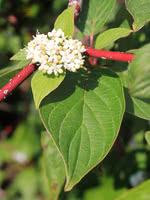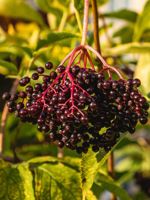Mon-Fri 9am - 5pm Mountain time
Red Osier Dogwood vs Bob Gordon Elderberry
Cornus sericea
Sambucus canadensis Bob Gordon
Red Osier Dogwood is a small deciduous shrub that features deep red stems and twigs year-round, with creamy white flowers in the spring. This shrub will add a nice pop of color to your yard.
Red Osier Dogwood is an excellent soil stabilizer. It is fast growing and becomes drought tolerant once well established.
Bob Gordon Elderberry is a Black Elderberry cultivar that produces berries that are larger and sweeter than other varieties, making it one of the top cultivars. It produces large clusters of white flowers that turn into large clusters of dark purple to black berries. The berries are well-suited for baked goods, jams, jellies, and syrups. It was selected from the wild in Missouri.
The large berry clusters that the Bob Gordon Elderberry produces will often end up hanging downward. This makes it more difficult for birds to feed on the berries. If birds are a concern, this might be the right berry for you.
Black Elderberries are considered to be partially self-pollinating. So while they will still produce some berries without cross-pollination, planting with another variety will increase yields. Consider planting with Black Elderberry or Ranch Elderberry.
Warning: the seeds, stems, leaves, roots, and uncooked berries are toxic to humans when eaten in quantity. Berries should be cooked to make them safe for human consumption.
Red Osier Dogwood Quick Facts
Bob Gordon Elderberry Quick Facts
Toxicity: leaves, stems, and uncooked berries are poisonous to humans
In row spacing: 0.9 m (3 ft)

